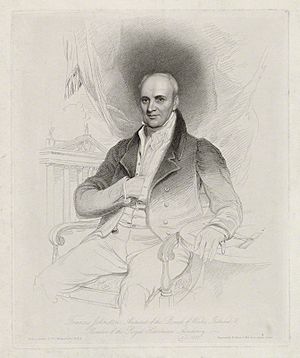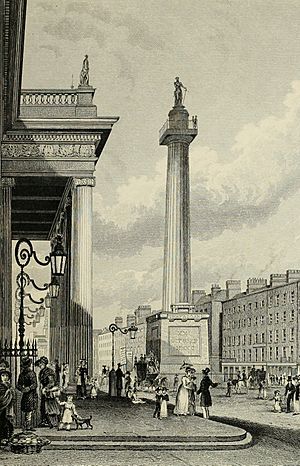Francis Johnston (architect) facts for kids
Quick facts for kids
Francis Johnston
|
|
|---|---|
 |
|
| Born | 14 January 1760 Armagh, Ireland
|
| Died | 14 March 1829 (aged 69) 64 Eccles Street, Dublin, Ireland
|
| Resting place | St. George's Church, Dublin, Ireland |
| Occupation | Architect |
| Parent(s) | William Johnston |
| Buildings | GPO Nelson's Pillar St. George's Church, Dublin Ballynegall House Daly's Club |
Francis Johnston (born 1760, died 1829) was a famous Irish architect. He is most known for designing important buildings in Dublin, like the GPO on O'Connell Street.
Contents
Life of Francis Johnston
Francis Johnston was born in Armagh, Ireland, in 1760. His father, William Johnston, was also an architect. Francis followed in his footsteps, learning about building design.
He first worked in Armagh. Later, he lived in Drogheda from 1786. Around 1793, he moved to Dublin. In 1805, he became an architect for the Board of Works. This was a government group that managed public buildings.
In 1824, Francis Johnston became the president of the Royal Hibernian Academy of Arts. This academy was a new art school. He even gave them a building for their headquarters in Dublin.
Key Architectural Works
Francis Johnston designed many important buildings across Ireland. His work shows two main styles: Neo-Classical and Neo-Gothic. Neo-Classical buildings look like ancient Greek or Roman temples. Neo-Gothic buildings look like old medieval castles or churches.
Famous Dublin Buildings
Johnston played a big part in shaping Georgian Dublin. This was a time when many grand buildings were being built.
- General Post Office (GPO): One of his most famous designs is the GPO on O'Connell Street. It was built to look grand and elegant.
- Nelson's Pillar: He helped design Nelson's Pillar in Dublin. This tall monument was started in 1808. It was sadly destroyed by a bomb in 1966.
- St. George's Church: He designed St. George's Church in Dublin. It was built starting in 1802.
- Chapel Royal: His Chapel Royal in Dublin Castle (1807–1814) is a great example of early Gothic revival style. This church inspired other architects in Ireland.
- Bank of Ireland: He oversaw the change of the old Parliament House into the Bank of Ireland. This happened between 1803 and 1808.
- Richmond Tower: He also built the Richmond Tower in 1812. This large gateway was later moved to the Royal Hospital in Kilmainham. He secretly placed his family's coat of arms above the arch. He hoped it would be found by future generations!
Other Notable Projects
Johnston designed many other buildings throughout Ireland:
- Townley Hall: Built between 1794 and 1798, this house near Drogheda is seen as one of his best works.
- Armagh Observatory: In 1789, he designed the Armagh Observatory.
- Daly's Club: In 1790, he designed a new clubhouse for Daly's Club in Dublin.
- Armagh Courthouse: He was responsible for the design of Armagh Courthouse, built from 1806 to 1809.
- Ballynegall House: This house in County Westmeath was built in 1808.
- Richmond Gaol: In 1813, he started work on Richmond Gaol, a prison.
- Charleville Forest Castle: He designed Charleville Forest Castle in Tullamore, County Offaly. It is considered one of the finest castles of its kind in Ireland.
- Slane Castle Gates: He designed the east gates of Slane Castle in County Meath.
- Tullynally Castle: He helped turn Tullynally House in County Westmeath into Tullynally Castle by 1803.
Francis Johnston lived for many years in his house at 64 Eccles Street in Dublin. He died in 1829 and was buried in the churchyard of St. George's Church.
Images for kids
-
East Gate of Slane Castle





